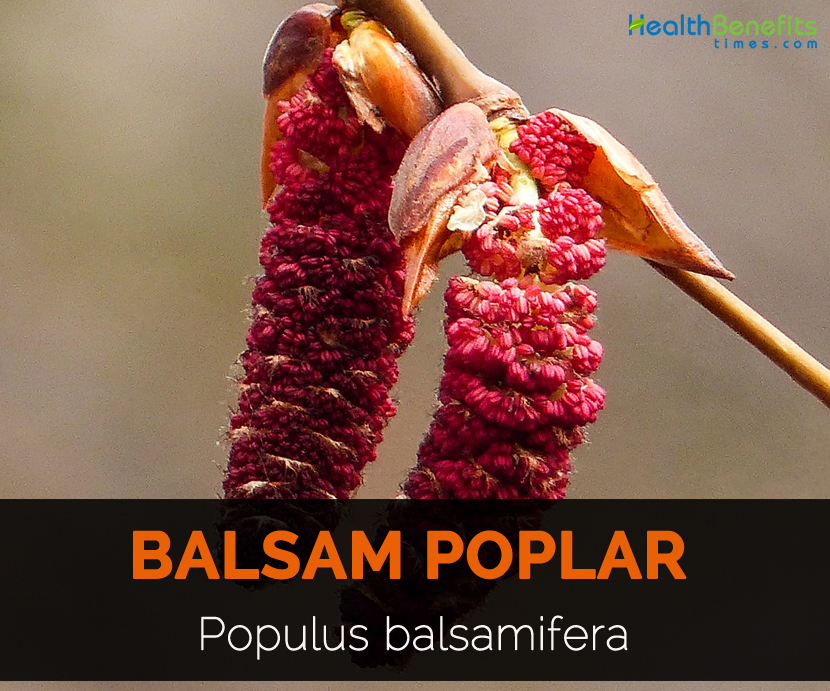| Balsam poplar Quick Facts | |
|---|---|
| Name: | Balsam poplar |
| Scientific Name: | Populus balsamifera |
This tree attains a height of 50–70 ft., with a trunk about 18 inches in diameter. The branches are smooth, round and deep brown. The leaves are ovate, gradually tapering and dentate, deep-green above and smooth on both sides. In America the leaf buds are in bloom in April, and this is the official part and time for collection. They have an agreeable, incense-like odour and an unpleasant, bitterish taste. The balsamic juice is collected in Canada in shells and sent to Europe under the name of Tacamahaea.
The Populus balsamifera is generally confused with the Populus canadensis, from whose buds we get the virtues known as the Balm of Gilead; but it is much the superior tree for medical purposes.
Plant description
Balsam trees measures 30 to 60 meters tall with straight, branch free trunk for more than half its length, forming a broad, open crown in open sites. Bark is gray to gray brown on mature trees which are deeply furrowed into flat ridges on older portions. Leaves are deciduous, alternate, simple, ovate-lanceolate to deltate but variable in size and shape on same tree. Flowers are male and female on separate trees which borne in pendent catkins. Fruits are globular capsules about 3-4 mm long which splits to release seeds about 2 mm long with tuft of long, white and silky hairs which are easily blown by the wind.
Leaves are simple, alternate, ovate, finely serrated and shiny dark green, paler and often blotchy orange below and petioles are long with glands at the leaf base.
Flowers
Flowers are dioecious, male and female are hanging, long pale yellow green catkins appears in May.
Fruit
Flowers give way to small, 2 valved and dry capsule which contains numerous small seeds. Capsules are lustrous green during development and turns dull green at the time of dispersal. Male flowers shed promptly and decay. Female catkins are shed shortly after dispersal is completed.
Facts About Balsam Poplar
| Name | Balsam poplar |
|---|---|
| Scientific Name | Populus balsamifera |
| Common/English Name | Balsam Poplar, Black cottonwood, Common black cottonwood, Western balsam poplar, Balsam cottonwood, California poplar, Bam, Eastern balsam-poplar, Bamtree, Hackmatack, Tacamahac poplar, Tacamahaca, Cottonwood, Heartleaf balsam poplar |
| Name in Other Languages | German: Balsam-Pappel, Balsampappel, Echte Balsam-Pappel; Lithuanian: Balzaminė tuopa; English: Eastern Balsam-poplar, Balsam poplar, Bamtree, Eastern balsam poplar, Hackmatack, Tacamahac poplar |
| Plant Size | 25 m tall |
| Bark | Dark furrowed |
| Flowering Season | April and May |
Uses
The buds are used as a stimulating expectorant for all conditions affecting the respiratory functions when congested. In tincture they have been beneficially employed in affections of the stomach and kidneys and in scurvy and rheumatism, also for chest complaints. The bark is known to be tonic and cathartic and will prove of service in gout and rheumatism.
Dose
Tincture of the buds, 1–4 fl. drams in water as needed. As a tea, 1 teaspoonful of the buds to 1 cupful of boiling water.
Externally
The buds are chiefly used in the form of ointments and plasters for counter-irritant purposes.
Culinary uses
- Dried inner bark is grounded into powder and used as a thickener in soups.
- Add it to cereals for making bread.
- Catkins are consumed raw or cooked.
Medicinal uses
- North American Indian tribes use it for treating various complaints such as skin problems and lung ailments.
- Leaf buds are antiseptic, antiscorbutic, expectorant, diuretic, tonic and stimulant.
- Use resin as a salve and wash for sores, wounds and rheumatism.
- Make it into tea and use it as a wash for sprains, muscle pains and inflammation.
- Use the tea internally for lung ailments and coughs.
- Put the buds in hot water and use it as an inhalant for providing relief from congested nasal passages.
- Bark is used for treating fevers and rheumatism and also provides relief from pain of menstrual cramps.
- Use the tea made from inner bark as eye wash and for treating scurvy.
- Rub the extract to skin diseases and also to relieve teething pain in babies.
References:
https://www.itis.gov/servlet/SingleRpt/SingleRpt?search_topic=TSN&search_value=22453#null
https://pfaf.org/user/Plant.aspx?LatinName=Populus+balsamifera
https://plants.usda.gov/plantguide/pdf/pg_pobat.pdf
https://en.wikipedia.org/wiki/Populus_balsamifera
https://plants.usda.gov/core/profile?symbol=POBA2
http://www.borealforest.org/trees/tree11.htm
Comments
comments
